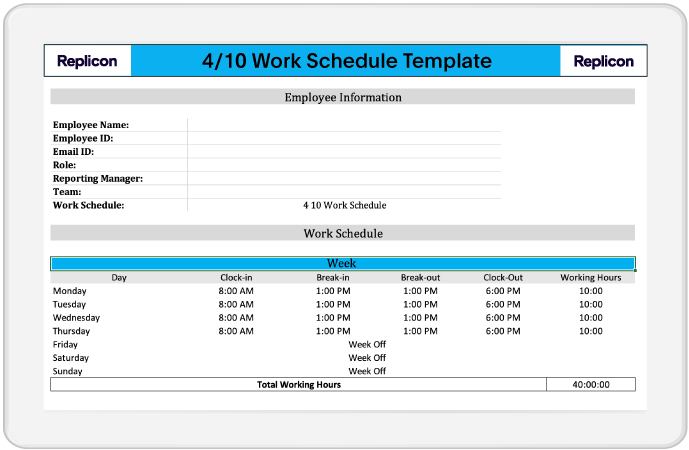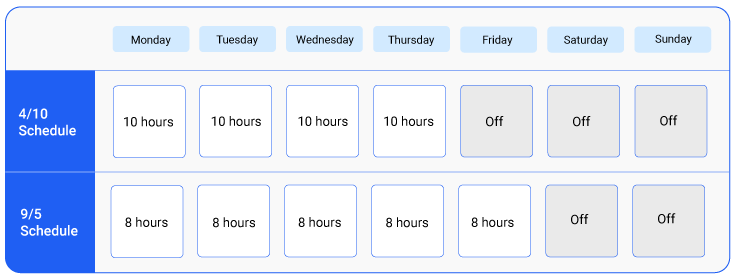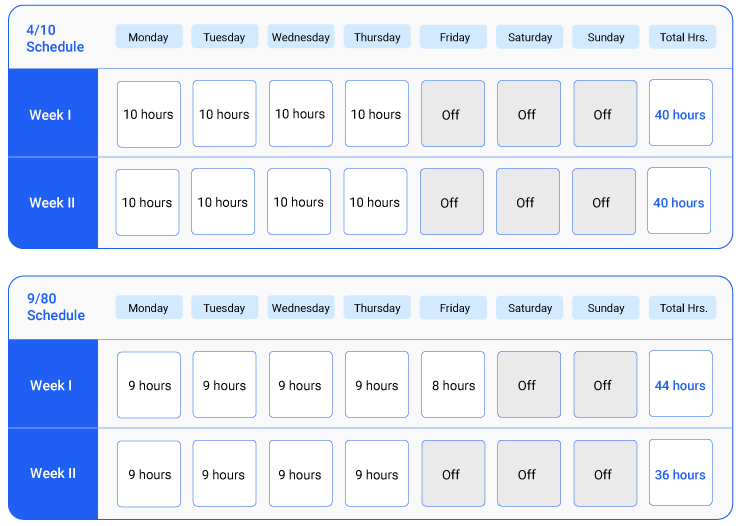What Is a 4/10 Work Schedule and How to Implement It? (Examples and Free Template)

In order to attract a large candidate pool and retain top talent, employers are increasingly experimenting with compressed workweek schedules that offer more flexibility and days off than regular schedules.
The compressed workweek is not a new concept. However, with the increasing demand for more flexibility among employees, this model is getting more attention than ever before.
Among various compressed workweek models emerging slowly, the 4/10 work schedule has gained a lot of popularity. This schedule squeezes the 40-hour workweek into four days rather than five days. This provides more days off over other conventional schedules.
In this blog, you’ll learn the fundamentals, benefits, and drawbacks of the 4/10 work schedule so that you can take a call on implementing this system properly if it works for your business.
What Is a 4/10 Work Schedule?
The 4/10 schedule is a compressed work schedule in which employees work for 10 hours each for four days over a seven-day cycle, thereby getting a total of 3 days off each week.
Also called the four-day workweek, this schedule squeezes 40 hours of workweek into four days rather than five. In other words, a 4/10 schedule allows employees to work only four days a week, unlike the conventional schedule, where employees work for five days. Usually, employers choose to keep Friday or Monday off. However, they can also provide time off in the middle of the week.
As explained, the workday in this schedule is longer (10 hours) than a workday of the regular schedule. However, this model rewards employees with three days off that they can utilize to relax & recharge, plan a trip, or complete other pending work.
Examples of the 4/10 Work Schedule
This is a sample of the 4/10 work schedule:
Monday: 8 AM – 6 PM
Tuesday: 8 AM – 6 PM
Wednesday: 8 AM – 6 PM
Thursday: 8 AM – 6 PM
Friday: Off
Saturday: Off
Sunday: Off
In a 4/10 schedule, employees work 10 hours each for four days. Therefore, in this example, during the first four days of the week, namely Monday, Tuesday, Wednesday, and Thursday, employees start work at 8 AM and end at 6 PM. After four days of work, they get three consecutive days off on Friday, Saturday, and Sunday.
Irrespective of what work timings employers choose to keep, the total number of work hours must be 40. Generally, employers prefer to keep Friday as a non-working day; however, they can choose to keep any other day off as well.
Variations of 4/10 Work Schedule
Flexible 4/10 Shift
The flexible 4/10 schedule enables employees to decide –
- When they’d like to avail the day off in a week – whether Friday, Monday, or any other weekday.
- The start and end timings of the workday; for instance, they can opt for starting at 10 AM and ending the work at 8 PM, and so on. However, the total work hours in a day should be 10.
4/10 Shifts
Some businesses require consistent customer-facing operations from Monday to Friday. So, such businesses looking forward to embracing a 4/10 schedule can divide their resources into two groups to ensure coverage throughout the week.
For instance, one group can work from Monday to Thursday, while the other group can cover the first group’s day off by working Tuesday to Friday. This way, an organization can cover all standard work days.
Seasonal 4/10 Shifts
Businesses like retail that require more resources during the peak season can onboard more people during that period to handle the extra workload. This way, staff can be available at all times when required.
Generally, peak seasons are the busiest period for business owners in which they experience a sudden surge in customers. However, the resources onboarded during peak season can be issued additional time offs or vacation plan during the normal months.
Advantages and Disadvantages of 4/10 Work Schedule
Advantages of 4/10 Work Schedule
Benefits For Employees
Less Commuting Time
Unlike the traditional 9-5 schedule, employees need to travel only for four days a week and not five days. Thus, they can save a day’s commuting time. In addition, this schedule has a longer shift, so employees either start or finish the work at a different time than other general shifts. This helps employees avoid the rush hour and spend less time on traveling.
Such reduced commuting not only saves employees’ time but is also beneficial for the environment as vehicle emission decreases to some extent.
Increased Productivity & Relaxation
This schedule provides three days of time off (usually consecutive) each week, which lets employees unwind and disconnect from work completely after a hectic week. Once employees return to work after a long weekend, they’re well-rested and ready to take on more responsibilities.
In short, the long weekend saves employees from burnout and keeps them motivated for their work. This results in increased workplace productivity.
Improved Work-Life Balance
Equipped with three days off each week, employees get ample time to spend with their families, friends or complete any personal work. They can also plan a short trip during this long weekend, which provides a mental reprieve from job stress.
What’s more, a long weekend gives employees an opportunity to devote more time to their hobbies, or personal interests, which they could not indulge in due to the busy office routine.
Benefits For Employers
Low Absenteeism and Lesser Use of Paid Time Off
The 4/10 work schedule provides ample time off to employees to complete their personal work and errands. Thus, they hardly need to use their PTO leaves. This alternative schedule provides 52 extra days off per year (apart from weekends), which employees can use to visit a doctor, complete bank-related work, or run other errands that can’t be done on weekends.
Assists in Hiring and Improves Retention Rate
Research shows that nowadays employees are increasingly seeking organizations that provide more flexibility and better work-life balance. That’s why switching to this alternative schedule can help employers attract the top talent in their organizations.
Moreover, employees would hardly think of quitting their current jobs if they have a flexible work environment and more days off. Therefore, this schedule assists employers in retaining their existing employees as well.
Reduction in Operating Costs
If organizations implement a 4/10 schedule, they can reduce their operating costs by keeping their offices closed for three days each week. In fact, as per a published report, when Microsoft Japan shifted to a four-day workweek schedule, their overhead expenses reduced, including electricity costs, which fell by 23%.
Increased Accountability to Complete the Tasks
A 4/10 schedule lets employees focus on their work without any distractions. Due to the longer work hours, employees are able to complete more tasks in a single day. Thus, armed with this schedule, employees won’t be able to procrastinate their tasks for a longer period.
In addition, it has been observed that employees feel more motivated to work when they have fewer days to work, as they want to finish their work before the long weekend.
Disadvantages of 4/10 Work Schedule
Disadvantages For Employees
Extended Hours
Working 10 hours a day may exhaust employees, especially if they’re used to 8 hours of the workday shift. Add to that the commuting time to and from work, and the shift can easily extend to 12 hours or more for many people unless they live near the office area.
Impact on Creativity and Productivity
Stretched working hours may prevent employees from having sufficient rest that leads to fatigue, and lower cognitive functioning. It has also been observed that working for long hours is counterproductive and can diminish the creativity of desk job workers. Plus, employees are prone to make more human errors during longer workdays as exhausted employees find it difficult to focus on their work.
Not Suitable for All Employees
A 4/10 work schedule may not work as a win-win situation for everyone. This is because some employees may be happy to devote additional hours on all workdays in exchange for more time off, whereas there’ll be others who may be uncomfortable working for long hours.
For example, if an employer chooses to start their office two hours early in the morning, then employees will have to adjust their routine to complete home errands and reach the office on time, which can also cause disruptive sleep patterns. Similarly, young parents who pick up or drop their children at school may find this schedule difficult to adjust to.
Increased Chances of Burnout and Stress
Employees working for ten hours straight per day may find this schedule taxing. They may feel overworked each day, leading to burnout and mental exertion. This schedule can do more harm than any good, especially for job roles that require creative thinking and imagination.
Also, extended working poses more challenges to specific sectors, such as driving or construction, where employees are required to work physically for a longer duration. To mitigate this problem, employees can take a short break at some intervals, in which they can walk around, take a nap, or munch on some healthy snacks.
Disturbed Work-Life Balance
The compressed schedule leaves little time for employees to spend with family on workdays. Plus, employees may find it too tiring to do their regular chores after a hectic day. This may result in frustration and job dissatisfaction in employees due to work-life imbalance.
Disadvantages For Employers
Incompatible Time With Clients and Business Partners
Most organizations and their clients usually work in 9-to-5 timings, so if you closely work with your clients or business partners, chances are that your additional 2 hours of work may fall outside their business hours. In such cases, your employee’s time may not be utilized productively.
This way, you may witness a decline in sales as communication hampers because of different time zones.
You can tackle this problem by redefining the work hours that align with clients’ work timings, while the extra hours can be utilized to focus on other job responsibilities.
Challenging for Small Enterprises
Organizations that require consistent customer-facing for five days a week may find the 4/10 work schedule unsuitable. In such cases, employers will have to divide their workforce into two shifts to fulfill the customer needs for at least five days per week. However, enterprises with staff shortage can’t divide their resources into multiple shifts, therefore, they may face difficulty with this scheduling.
Long Working Hours With Less Output
Every person has different productivity hours. However, majorly people are the most productive during the morning time, and as the day progresses, their productivity starts reducing. So, in spite of the employees working 10 hours a day, productively they’ll be working for 6-7 hours at most. Such employees may be investing more time at the workplace, but they may not be producing outcomes as expected.
Other Challenges for Management
There are overtime laws defined for every region that organizations need to comply with, and not following them can land you into trouble of litigation. For instance, in certain states like California, and Alaska, work done beyond 8 hours a day is considered overtime. Therefore, depending on the local labor laws, employers may need to pay overtime compensation for extra hours.
That’s why employers must look into the state’s overtime laws and discuss with management on how to process payroll to stay compliant.
Tip: It’s suggested to consult a lawyer or attorney to prevent such compliance issues. Having a proper time attendance tool with inbuilt compliance check systems also helps in a big way.
Is a 10-Hour Work Day Too Long?
Not everyone is comfortable with 10 hours of working in a 4/10 schedule; however, many employees are drawn to the 4/10 model as it provides more flexibility and work-life balance over the traditional schedule.
Employees can work 10 hours per day in exchange for more days off that they can utilize to rest and recharge. Plus, the 10-hour-long work allows them to complete more work in a day without being much distracted.
Though 10-hour working for four days with long weekends may look intriguing to some employees, some may find this long workday too tiring.
It has been observed that employees are productive during the start of their workday, and as the day progresses, they tend to feel lethargic, due to which they become less productive. In fact, a survey reveals that an average employee is most productive only for approximately 3 hours in an 8-hour workday. Thus, chances are that 10 hours of working can further lessen employee productivity.
Such ambiguous details can land employers in a dilemma of whether or not this work schedule is a good choice for their organization.
So what’s the way out?
A complete analysis of all factors that work for a business and then implementing the schedule using best practices.
Continue reading to know how to do this. You’ll learn more about what makes this schedule popular, how different alternative schedules work, which industries are best suited to adopt this schedule, and finally, how to implement this system in the best way.
Why Is the 4/10 Work Schedule So Popular?
Today, most employees are looking for a work schedule that provides them with greater flexibility, more time off, and so on. This is why most organizations are experimenting with alternative work schedules.
Among numerous types of alternative approaches coming into the picture, 4/10 has appeared as the most sought-after schedule since this compressed schedule provides more time off every week than the standard 9-to-5 schedule.
According to one survey conducted by Qualtrics, nearly 92% of U.S. employees want a four-day work week, even if it requires working longer hours, citing that it may help in improved mental health and increased productivity. However, it rings true that this schedule may not fit well for all job types.
It may work well for a few industries and office settings but can do more harm in other industry types, especially those that demand consistent physical work. Therefore, it’s recommended that employers must assess the pros and cons of this schedule to evaluate if this model aligns with their organization’s needs.
Industries Where 4/10 Work Schedules Can Be Implemented
The 4/10 schedule is the best fit for industries that require long working hours but for a few days. However, as discussed above, sectors that require customer-facing operations for all five days a week can split their resources into two shifts so that they can have coverage for all five weekdays. Some of the industries where this schedule works well are:
Manufacturing
The manufacturing industry may require a consistent availability of workforce plus longer working hours for producing, fabricating, or manufacturing the goods. They can also avail of seasonal 4/10 shifts that allow them to meet their demand during the peak season of manufacturing.
Healthcare
The 4/10 work schedule and the healthcare sector go hand in hand, as this schedule enables healthcare workers to devote sufficient time to provide quality care to their patients while having ample time offs from work after a hectic weekday.
Retail
Retail sector requires customer-facing employees to work for long hours to sell goods and services to consumers. Here, employers can choose to divide their workforce into two shifts to meet customer demand.
Food Service
Today, food-related businesses are growing rapidly across the globe and look forward to entertaining more customers’ requests by working longer hours. Thus, this schedule aligns well with this business sector, as employers can retain their current employees while gaining more customers.
Comparison of 4/10 With Alternative Schedules
4/10 Work Schedule vs. Regular (9-5) Work Schedule
In both schedules, employees work for 40 hours a week, but the 4/10 is a compressed work schedule.
4/10 Schedule: Employees work 10 hours each for four days a week and receive three days off each week.
9-5 Schedule: Employees work 8 hours each for five days a week and receive two days off each week.
4/10 Work Schedule vs. 9/80 Work Schedule
In both schedules, employees work for an overall 80 hours in two weeks. However, in 9/80 work schedule, the shift is split into a 2-week timeframe.
4/10 Schedule: Employees work 10 hours for four days a week and receive three days off each week.
9/80 schedule: The schedule is divided into a bi-weekly time frame. In the first week, employees work 9 hours for four days and 8 hours for one day, and in the second week, they work for 9 hours for four days and receive Friday off.
4/10 Schedules vs. 2-2-3 Work Schedule
The 4/10 schedule is implemented on a weekly basis; however, 2-2-3 is a rotational cycle of 28 days that requires resources to split into four groups.
4/10 Schedule: Employees work 10 hours for four days a week and receive three days off each week.
2-2-3 Schedule: It’s a rotational cycle of 28 days, where four teams work to provide 24-hour coverage. Each team works two consecutive day shifts, followed by two days off and then three more days of working. Every shift is 12 hours, so employees’ weekly hours remain the same.
How to Implement the 4/10 Work Schedule
Once you’ve decided to implement this schedule in your organization, it’s time to find out if your business can do well with a four-day workweek or would require five days of working.
If you want to keep your business open five days a week, you need to split your employees into two groups so each group can avail of an extra day off on a different day. For example, if group 1 receives an extra day off on Friday, then group 2 can obtain an extra day off on Monday. This way, you can keep your business open for a total of 5 days per week.
Some employers provide their employees the freedom to decide the day of time off. Generally, employees opt for Monday or Friday to avail of the long weekends; however, some employees may also prefer any other weekday in between the week, like Wednesday, to take a rest amid the hectic work week.
However, employers who provide their employees the freedom to choose their day off may find themselves in hot water, as the scheduling with arbitrary day off choices can make things more complex. For example, they’ll need to keep a tab on which employees had a day off on which day and whether or not their total work hours per week sum to 40.
As a solution, you can leverage our Knowledge Workforce Management Solution from Replicon that streamlines the process of scheduling by assigning various schedules and shifts to different employees with ease. Thus, you can keep a tab on employees’ work timing, shifts, and schedule, irrespective of which model you opt for.
4/10 Schedule Free Template from Replicon
Check out this free 4/10 work schedule template from Replicon to streamline the implementation of this schedule in your organization. This downloadable template is available in both MS Excel and Google Sheets formats. To use it, consider entering clock-in, break time, and clock-out times for four workdays. After taking inputs, it will show the total working hours in a week, which should be equal to 40.
The template will generate an error if –
- The workweek hours are below or above 40.
- The total hours for each day is below 10.
Click on the buttons below to start using a template for the 4/10 schedule.

Top 5 Tips to Implement a 4/10 Work Schedule
Communicate and Take Feedback
Before implementing a 4/10 work schedule in your organization, take suggestions from employees, stakeholders, and business partners, like what’s their take on this new schedule. See how they respond to this new schedule, how many support it, and how many employees are not comfortable with the long working hours. Also, clearly spell out the benefits they may get and discuss how this paradigm will be implemented.
Create a Formal Policy
You can create a formal written policy that should entail guidelines and specifications related to the work schedule, days off, PTO policy, and overtime to avoid any misconduct or ambiguity. Communicate how overtime will be handled in this new schedule and when an employee will be eligible for overtime pay.
Leveraging Tools to Track Employees’ Hours
In order to implement this schedule, it’s essential to track the exact work hours of employees per week. This requires leveraging the appropriate tools so that there’s no room for any error. For example, you can opt for an efficient time-tracking software like Replicon that records the exact working hours of each employee so that you have visibility into their work shifts, days off, and payroll processing. Besides, you can also use a scheduling software to assign shifts to employees if you have split your resources into multiple teams.
Start With a Trial First
Go for a trial period first before implementing this schedule right away. Apply this schedule among certain teams and see how well it goes. This trial will help you assess if this schedule is good to go or has some challenges that need to be sorted out first. Once you’re sure that this schedule can run smoothly after giving employees ample time to adjust, consider extending it throughout the organization or business.
Give Breaks
You can even map out other ways to keep employees productive during a 10-hour workday by imposing mandatory breaks after a certain interval or leveraging the Pomodoro technique. During the break time, you can introduce mind-relaxing activities or fun games to help them disconnect from work for a while.
Implement an Open Door Policy
Introduce an open-door policy to encourage an open line of communication. If some employees feel fatigued or overstressed due to the long work hours of the 4/10 schedule, they should be able to express their issues and concerns with management freely. Plus, management should proactively work to resolve their issues.
Should You Go for the 4/10 Work Schedule?
Factors like the industry your organization belongs to, its customer needs, the working time of clients & business partners, and employee preferences play a major role in determining if this schedule will work for you.
To get the most out of it, here’s how to go about it:
- You can communicate with your employees and take their views on implementing this new schedule.
- Check all the pros and cons to see if your business wouldn’t be impacted because of extra days off.
- Consider the potential issues or contingencies that may arise upon the implementation of this schedule.
- Discuss with your clients and stakeholders if their work timings can be aligned with your organization’s timing.
- If your organization needs consistent customer-facing or service delivery, see if you can divide your workforce into two groups to provide 5-day coverage a week as part of the 4/10 work schedule.
There are various types of alternative work schedules available today; you can experiment with all schedules for a stipulated duration. Once you analyze the results from all schedule types, you can make a decision and implement the right schedule for your organization.
Frequently Asked Questions
Q.1 How does a 4/10 schedule work?
The 4/10 schedule refers to the system where employees work for 10 hours for four days a week and get a total of 3 days off.
Q.2 Is a 4/10 schedule better than a 5/8 work schedule?
In the 5/8 work schedule, employees work for five consecutive work days for eight hours each. However, in a 4/10 schedule, employees have to work for 10 hours for four days each week. Both schedules have their own advantages and disadvantages, and it’s up to the employer to decide which schedule can align well with the organization’s needs.












